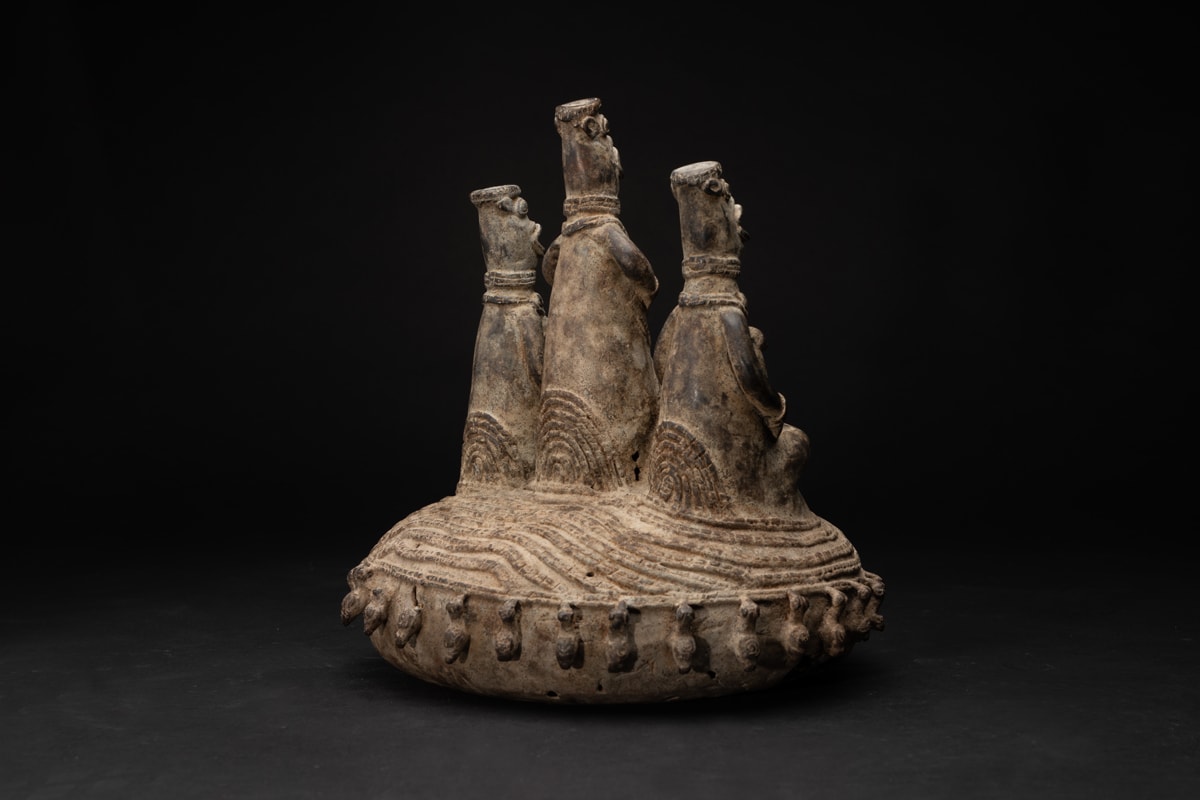Komaland Bronze Sculpture Depicting Three Figures, 14th Century CE - 18th Century CE
Bronze
height 25.4 cm
height 10 in
height 10 in
PF.4006 (LSO)
Further images
This remarkable piece is believed to be an altarpiece from one of Africa’s least understood groups, the Koma people of Northern Ghana. It is a large, rounded hollow mass decorated...
This remarkable piece is believed to be an altarpiece from one of Africa’s least understood groups, the Koma people of Northern Ghana. It is a large, rounded hollow mass decorated with wavy lines on the upper half and zoomorphic/anthropomorphic forms. The piece is surmounted by three seated figures made in the traditional Komaland style, with corpulent bodies, short limbs and columnar heads with flat tops. The central figure is male, the lateral individuals are female. The faces are very similar, with circular appliqué eyes, nugatory noses and open mouths. The lateral figures appear to be drumming on drums held on their laps, the drumsticks resting on their breasts. The central figure is holding an unidentified object on his lap. They are all decorated with jewellery, and the entire piece has a dark, uneven patina of age.
The Komaland people are almost completely obscure, and since the original discovery of their artefacts in 1985 very little further research has been carried out. Basic dating indicates a range of perhaps 500 years between the 13th and 18th centuries. They are known to have been very able ceramicists, and made pots, figures, heads, talismans (anthropomorphic and zoomorphic) and a variety of other items; they were also, unusually, competent metalworkers, and produced a plethora of weaponry and ornate helmets. Their society was presumably sedentary, agricultural and hierarchical, as indicated by the range of crafts available, the tumuli in which they were found, and the size of the sites.
The significance of this piece is thus almost totally mysterious. Most Koma pieces are ceramic representations of single humans, so metal objects of this sort are very rare. The size of the piece and its general layout would seem to suggest a centralised, institutional, adorational object that would best be described as an altar. The identity of the personages depicted is uncertain, but their apparel and pose would suggest that the male is a chief, ancestor or deity, while the accompanying females are devotees or wives. This must have been an important and significant piece at its time of manufacture. Whatever the reason for its manufacture, this is a rare and fascinating piece of ancient African art.
The Komaland people are almost completely obscure, and since the original discovery of their artefacts in 1985 very little further research has been carried out. Basic dating indicates a range of perhaps 500 years between the 13th and 18th centuries. They are known to have been very able ceramicists, and made pots, figures, heads, talismans (anthropomorphic and zoomorphic) and a variety of other items; they were also, unusually, competent metalworkers, and produced a plethora of weaponry and ornate helmets. Their society was presumably sedentary, agricultural and hierarchical, as indicated by the range of crafts available, the tumuli in which they were found, and the size of the sites.
The significance of this piece is thus almost totally mysterious. Most Koma pieces are ceramic representations of single humans, so metal objects of this sort are very rare. The size of the piece and its general layout would seem to suggest a centralised, institutional, adorational object that would best be described as an altar. The identity of the personages depicted is uncertain, but their apparel and pose would suggest that the male is a chief, ancestor or deity, while the accompanying females are devotees or wives. This must have been an important and significant piece at its time of manufacture. Whatever the reason for its manufacture, this is a rare and fascinating piece of ancient African art.
Literature
V19
1
of
32













